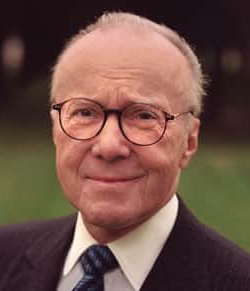
Gerald D. Hines, founder and chairman of the preeminent real estate firm Hines, died on August 23, 2020. He served as a Trustee of the National Building Museum from 1982 to 1991 and was a recipient of the Museum’s Honor Award in 2000, which recognizes individuals and organizations that have made significant contributions to our built heritage.
Hines was widely regarded and regularly honored as a visionary in the commercial real estate industry. He transformed a small startup, established in Houston, Texas, in 1957, into an international powerhouse, renowned for developing, owning, and managing some of the world’s most recognizable architectural landmarks across five continents. With more than 4,800 employees, the Hines corporation is active in 225 cities in 25 countries today.
Hines had a well-established reputation for hiring outstanding architects and was known for his attention to detail and insistence on using the best materials, systems, and procedures. Throughout his career, Hines teamed with renowned designers including, among others, Lord Norman Foster; Bruce Graham and David M. Childs of SOM; Gyo Obata; Philip Johnson and John Burgee (15 projects in all); I.M. Pei and Harry N. Cobb; Cesar Pelli; Kevin Roche; Robert A.M. Stern; A. Eugene Kohn and William E. Pedersen; Charles W. Moore; Frank O. Gehry; Jon Pickard; and Jean Nouvel.
The Hines legacy includes many landmark buildings that are both architecturally distinctive and financially successful. He had a particularly dramatic impact on the Houston skyline: Pennzoil Place in Houston, designed by Johnson/Burgee, was named Building of the Year in 1975 by former New York Times critic Ada Louise Huxtable; Williams Tower, also by Johnson/Burgee, was named Skyscraper of the Century in the December 1999 Texas Monthly magazine.
In 2007, David Childs, chairman emeritus of Skidmore, Owings and Merrill, said, “Hines’ attention to architecture has been good not only for the profession but also for urbanism, as his unwavering concern for the quality of his buildings extends beyond the plot of land and the frame of the site to the community.”
Hines was rightfully recognized widely for his contributions across the decades. In addition to receiving the National Building Museum Honor Award in 2000, he received an honorary doctorate in engineering from Purdue University and was honored by numerous other organizations; the Urban Land Institute bestowed its Award for Excellence on more than one Hines project, and in 2002 awarded him the Prize for Visionaries in Urban Development. In 1997, the University of Houston College of Architecture paid tribute to him and his family for their philanthropy by renaming the school the Gerald D. Hines College of Architecture.
